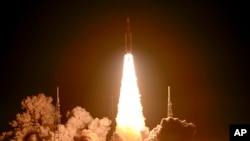In the early morning hours of November 16, the Artemis 1 moon rocket successfully launched from the Kennedy Space Center, starting the Orion spacecraft's journey to orbit the Moon and marking a major step toward the goal of returning humans to the Moon by 2025. NASA has named its lunar program Artemis, after the twin sister of Apollo in a nod to the successful Apollo-era moon landings. The final Apollo mission to the Moon occurred in December of 1972.
"We are all part of something incredibly special, the first launch of Artemis, the first step in returning our country to the Moon and onto Mars," Artemis 1 Launch Director Charlie Blackwell-Thompson told the launch team after liftoff. "What you've done will inspire the next generation."
The Artemis 1 launch was more than a decade in the making and faced repeated delays due to weather and technical issues. The Orion spacecraft will travel about 40,000 miles beyond the Moon's far side, farther than any human-rated spacecraft, according to NASA. The Artemis 1 test flight is scheduled to culminate with Orion's splashdown in the Pacific Ocean on December 11.
“The successful launch of Artemis 1 is the result of cooperative efforts to explore space, achieve a sustainable presence on the Moon later this decade, and prepare to conduct a historic human mission to Mars,” said Secretary of State Antony Blinken in a statement.
“Through the Artemis program, the United States is building the broadest and most diverse international human space exploration coalition in history, focused on making scientific and technological discoveries to advance our deep space efforts and return many benefits to our home planet,” said Secretary Blinken. “We look forward to continued work with international partners on future missions.”
With the Artemis Accords, the Department of State and NASA are bringing nations together through a common set of principles grounded in the 1967 Outer Space Treaty to guide civil space exploration, and set the stage for peaceful, responsible, and productive cooperation in outer space.
With the successful launch of the Artemis 1, NASA is one step closer to returning mankind to the Moon. As the last astronaut to walk the Moon’s cratered surface, Eugene Cernan, said "we leave as we came and, God willing, as we shall return, with peace and hope for all mankind.”
Successful Launch of Artemis 1

In the early morning hours of November 16, the Artemis 1 moon rocket successfully launched from the Kennedy Space Center, starting the Orion spacecraft's journey to orbit the Moon and marking a major step toward the goal of returning humans to the Moon by 2025.













